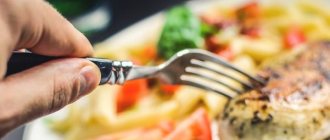What are the benefits of Soviet Union diets?
It was in the USSR that the so-called tables appeared, which many have heard of. Number tables are still used in the treatment of various diseases. We must remember that the USSR was the first country that bothered to take care of developing a diet at the state level. Remember that Thursday was fish day in the USSR? All canteens fed workers fish dishes. This was the Decree of the People's Commissariat of Food Industry.
Moreover, then ordinary women did not have personal nutritionists, pills and weight loss products, or detox centers. But many actresses of that time had very good figures. And this is based not on overseas dishes, but on simple, widely available products and iron willpower. The list of Soviet diets will take more than one page, so let’s look at the most popular diets of the Soviet era.
The Numbered Diet of the 50s
Healthy foods for weight loss
During this period, another slender actress, Lyudmila Gurchenko, became the ideal for Soviet women. But she was not a supporter of a particular method of losing weight.
We recommend reading
In the 50s, Soviet nutritionist M. Pevzner developed special nutritional methods called tables. They had a therapeutic or preventive effect and were numbered according to the diseases for which they were indicated. For example, table No. 1 was recommended for ulcers, No. 4 for intestinal diseases, No. 12 for restoring the functioning of the nervous system.
To get rid of excess weight, diet No. 8 was created. According to this method, the following foods are allowed:
- flour products: rye bread;
- cereals;
- vegetables that do not contain starch;
- lean meat;
- lean fish;
- seafood;
- low-fat milk and fermented milk products;
- raw fruits.
Soviet-era diets. Chronicles of Moscow life
004 Diets of the Soviet era Chronicles of Moscow life
Soviet millionaires. Chronicles of Moscow life
Table No. 8 has a list of prohibited foods:
- flour products: bakery products made from premium flour, baked goods, pasta;
- vegetables: potatoes, legumes;
- meat: fatty varieties, smoked meats, sausages, canned food;
- fish: fatty varieties;
- cereals: semolina, pearl barley;
- sweets.
“Table number eight” according to Pevzner
Manuil Pevzner was the chief nutritionist in the USSR. It was he who decided that the best routine would be three meals a day. He is also the author of the idea of a three-course lunch: first, second and compote. Pevsner first developed the idea of "tables" which were used to treat common illnesses. Of these, table No. 8 stands out - the main diet of the USSR. It was used to combat obesity.
Stew, bake or boil foods, fried foods should not be eaten, reduce calories and eliminate fast carbohydrates - these are the basic rules of nutrition according to Pevzner. The conditions within table No. 8 allowed us to eat 5–6 times a day. If the case was advanced and the fat had to be removed quickly, the diet was reduced to 1200 calories, and the person was sent to a medical facility.
Prohibited foods included all baked goods, sugar and everything containing it. In addition to fast carbohydrates, you should not eat meat with a lot of fat, all confectionery products, semi-finished meat products, hot or fatty sauces, fatty milk products and some cereals (white rice and oats). The amount of salt was reduced and spices were minimized.
The approximate schedule of table 8 for the day looked like this:
- For breakfast we eat low-fat cottage cheese with vegetable salad.
- 3 hours after breakfast, the second breakfast comes, and here we eat a few apples.
- For lunch we eat borscht with lean meat. Only low-fat sour cream is added to borscht. As a second course, some boiled meat and stewed cabbage.
- For an afternoon snack we drink low-fat kefir.
- For dinner, boiled or baked fish, complement it with vegetable salad. Alternatively: buckwheat and steamed veal cutlet.
- Before bed, a glass of skim milk.
As you can see, this Soviet diet resembles proper nutrition with a priority content of protein products in the diet. The Pevzner diet is very gentle. You will not feel hungry. Weight loss on table No. 8 - 2 kg per month. The duration of such nutrition can be very long, even throughout life. It does not contain harmful carbohydrates, which in any case are healthier to exclude. According to BJU, everything is balanced - there is an abundance of vitamins, microelements and fiber. USSR diet products and menus can be changed to alternative ones. Fish for chicken breast, cottage cheese for natural yogurt and kefir.
Lyubov Petrovna and her diet
In the 30s, the idol of girls throughout the country was the famous actress Lyubov Orlova.
Naturally, everyone also wanted to become like her. — breakfast and lunch only; — two days a week on the water; - breakfast: a glass of water with lemon juice, two boiled eggs, a slice of bread; - lunch: 100 g of lean meat, some vegetables.
The actress never tried to adhere to any rules, but still, over time, this diet was given the name Orlova.
Mono-diet on parsley
After the end of the war, people who got rid of constant stress were able to think about proper nutrition again. And although after general militarization, sports figures “a la a girl with a paddle” became popular, after the appearance of Lyudmila Gurchenko, women began to desire a slender, thin figure. And the “Twiggy syndrome” did not bypass the Soviet Union.
Of course, other actresses copied Gurchenko’s image. And it was the fragile Lyudmila Markovna who began to appear on TV more and more often. Losing weight, as always, was not easy, and those who wanted to gain a slim figure came up with new diets. Although nutritionists advised against resorting to extreme methods, mono-diets have become very popular. And the Soviet diet based on parsley became the most popular.
But the discussion here was not about parsley leaves, but about the roots, which should have been eaten grated. The root was eaten three times a day. You cannot live long on parsley alone, so you could eat other permitted foods, but in small quantities, no more than 200 g per day. Those allowed included healthy sources of protein such as cheese, lean meats, eggs and dairy products.
Since, apart from parsley, there are no vegetables or fruits, vitamin deficiency may appear, and therefore you cannot go on a diet for a long time, like on any other mono-diet.
An approximate schedule for one day looks like this:
- for breakfast, one tablespoon of mashed parsley, washed down with tea or coffee;
- for lunch we take another tablespoon of root and 100 g of boiled meat;
- for an afternoon snack, along with a spoon of root, 100 g of dairy products, for example, cottage cheese or cheese;
- For dinner we drink a glass of low-fat kefir.
The best diets of the USSR: how to lose weight in the Land of the Soviets
Soviet women remained women, despite the need to participate in kindling the fire of the world revolution, building socialism and fighting for world peace. They followed fashion, loved romantic songs, watched melodramas and were looking for a way to quickly lose weight.
“Table number eight” according to Pevzner
The USSR is the only country in the twentieth century where diets and healthy eating were dealt with at the state level. In 1930, the Institute of Nutrition was even created, which developed a balanced diet for all segments of society.
It was Soviet nutritionists and, in particular, their main guru, Manuil Pevzner, who introduced three meals a day, hot breakfasts and a three-course lunch. They also created the famous “tables” - diets used during the treatment of various diseases. For example, “No. 8” is for the treatment of obesity.
To overcome this disease, Soviet nutritionists proposed reducing calorie intake to 1800 per day, for which the use of foods containing carbohydrates and fats was reduced. Food was served unsalted, unpeppered, and spices were used in minimal quantities.
It was also necessary to completely abandon frying - foods can be stewed, boiled and baked. Meals are fractional, divided into 5-6 times a day.
In advanced cases, it was proposed to limit the diet to 1200 calories, but the person was sent to the hospital.
The peculiarity of all Pevzner’s diets is that foods were divided into those allowed for consumption and those completely prohibited. The latter in table No. 8 included all rich bakery products, incl. bread of the highest and first grade, any confectionery, fatty meat, sausages, sausages, canned meat, fatty fish and any salted, smoked, canned, all fatty dairy products, soups with cereals, potatoes, beans and pasta, rice, oatmeal, beans and legumes, semolina and pasta, ice cream, sugar, honey, sweet berries and fruits, any sauces, including ketchup and mayonnaise, cocoa and juices with sugar.
A sample menu, taking into account all the recommendations, would look like this:
• In the morning: low-fat cottage cheese and vegetable salad.
• After 2-3 hours: a few apples.
• Lunch: lean borscht, to which you can add a little sour cream, separately boiled meat with a side dish (stewed cabbage).
• Afternoon snack: low-fat kefir.
• Dinner: boiled fish and vegetable salad.
• Before bed: milk.
Orlova's diet
The thirties in the USSR passed under the sign of Lyubov Orlova. The first Soviet movie star reigned not only on the screen and in social life, but also in the minds of women. Millions of women in the country cut their hair and dressed “like Orlova,” but they were especially awestruck by her wasp waist. An extremely widespread myth was that the coverage was only 42 centimeters.
At the same time, a special diet was going around the Union - a “secret”, thanks to which the actress maintained her slim figure. In fact, Orlova’s proportions were truly magnificent, but we were still talking about the biologically possible 47-49 centimeters. And it’s hardly worth attributing the authorship of the diet to her.
The version of the “Orlova diet” that was in use right up to the war was extreme. Two meals a day were expected, for breakfast a small piece of bread and two hard-boiled eggs, for lunch some vegetables and up to 200 grams of meat.
The diet is already limited, so twice a week there are fasting days on the water, without a gram of food. It would be difficult for an actress to act in films and actively tour with such a diet. Already in the sixties, a more gentle option appeared.
It already had four or even five meals a day, a more balanced menu, without fasting, but meat and fish were completely absent, and everything fried and fatty was also prohibited.
All foods had their own time: porridge in the morning, vegetable soups at lunch, some dairy products, fresh vegetables and herbs in the afternoon, fruits in the evening. If you felt hungry at the end of the day, you were allowed to drink a glass of broth.
The menu looked like this:
• Breakfast: buckwheat porridge with raisins and nuts.
• Lunch: bean soup without frying with bread.
• Afternoon snack: green salad with cucumber and cheese.
• Dinner: fruit salad.
Mono-diet on parsley
In the fifties, the country had already recovered from the consequences of the war, and issues of proper nutrition and a healthy lifestyle again began to worry women. But the general militarization of society led to the fact that athletic figures with broad shoulders and strong hips were in fashion.
Lyudmila Gurchenko broke this trend. Her slender figure drove not only men, but also women, crazy. Just as they tried to copy her image in the movies, cute and slender actresses began to appear on the screens (for example, Anastasia Vertinskaya, Lyudmila Marchenko and Nadezhda Rumyantseva), so ordinary girls suddenly became obsessed with the idea of losing weight.
There was no special literature, official medicine advised not to bother your head with trifles and to eat a balanced diet, so the battle with extra pounds took on wild forms. The beauties drank vinegar, castor oil and even completely refused food for several weeks.
Various mono-diets were used: rice, watermelon, buckwheat porridge. Their essence was the same: the diet consisted exclusively of one product. Among others, the parsley diet was especially popular.
We are not talking about parsley leaves, although they can also be added to dishes, but about its grated root. It was this that was suggested to be eaten three times a day. Naturally, you can’t last long on it alone, so they added various products. During the diet, cheese, cottage cheese, meat, eggs, kefir were allowed - but just a little bit, literally 100-200 grams per day. Due to the complete absence of vegetables and fruits, this diet was suitable only for healthy people, and some managed to stay on it for months.
One day's menu would look like this:
• Breakfast: tea or coffee and a tablespoon of grated parsley root.
• Lunch: 100 grams of boiled meat and another spoon of parsley.
• Afternoon snack: 100 grams of cottage cheese or cheese and a little more parsley.
• Dinner: you can “treat” yourself with a glass of kefir.
Plisetskaya's diet
Soviet ballet is not only the Bolshoi Theater and its principal dancers. Every year, choreographic schools produced thousands of ballerinas, 48 opera and ballet theaters operated throughout the country, plus another 28 operetta theaters were ready to accept girls who did not qualify for the big stage.
It was in this environment that a diet appeared in the sixties, the authorship of which is attributed to the great ballerina of the twentieth century, Maya Plisetskaya. It is difficult to say how reliable this is. As you know, once answering a journalist’s question about a way to stay in shape, Plisetskaya simply replied, “I’m sitting without eating!” Nevertheless, among the people, the nutrition system with the name prima was at one time extremely popular.
It should be noted right away that Plisetskaya’s diet is not intended for long-term use; it is in its purest form a fasting menu designed for a week. The rest of the time, they advised to increase the amount of fish, fresh fruits and vegetables in the diet, limit or eliminate salt altogether, and pay attention to Japanese cuisine.
But in general, an individual approach was welcomed. After unloading, the diet was recommended to include as many of your favorite (low-calorie, of course) foods as possible, and not torment yourself with obligatory cereals. And they were gentle around mealtimes. No strict prohibitions on late dinners and snacks after six.
The fasting part of the diet lasted seven days and included three meals a day. At the same time, snacks were allowed, but only with fresh non-starchy vegetables and unsweetened fruits: tomatoes, cucumbers, apples, and the like. Considering that ballet also involves daily rehearsals with serious physical exertion, I managed to lose a significant amount of weight this week. If you lead a more relaxed lifestyle, then the effect will not be so noticeable.
Menu these days:
• Breakfast: 100 grams of oatmeal with water.
• Lunch: 150 grams of vegetable soup, 100 grams of vegetable salad.
• Dinner: 30 grams of baked fish, 60 grams of rice and 100 grams of fresh vegetables.
Atkins diet
Despite the Iron Curtain and the lack of normal translation, the Robert Atkins diet reached the USSR quite quickly. Actually, as throughout the world, the surge of interest was caused by the appearance of an article in the June issue of Vogue in 1970. The magazine was not distributed in the Union, but there were people who read it.
As a result, the “high society” of Moscow already in the mid-seventies excluded carbohydrates with all their might and carried with them homemade tables of foods that contained them. Perhaps it was the lack of official publication that led to the emergence of many versions of it, including the “Kremlin diet,” which is very popular to this day.
The main principle of the Atkins diet is an almost complete rejection of foods containing carbohydrates. He believed that the human body spends more calories burning them rather than fat. He argued that you need to stick to his diet all the time, without interruptions, and this will allow you to rebuild your metabolism, and not just lose weight once. Therefore, I divided the whole process into four phases: from preparing for the transition to a diet to maintaining the resulting weight.
Another feature of the food system was the relative freedom in creating the menu. It was only recommended not to exceed the daily carbohydrate limit. In the first phase, for example, no more than 20 grams per day per day.
In the third and fourth phases, the number of grams of allowed carbohydrates for each was determined individually, depending on the body’s reaction, and on whether the person began to gain weight again. Therefore, there was no direct ban on any products, but one must understand that some unfortunate 100 grams of beans contain a little more than 60 g of carbohydrates; it simply did not fit into the menu. Is it worth mentioning other side dishes?
But with almost no restrictions, one could eat meat, fish, seafood, vegetable fats, dairy products, most vegetables (except potatoes) and nuts. Any drinks were also allowed, provided they did not contain sugar.
There was no daily menu, but one of the options in the USSR looked like this:
• Breakfast: scrambled eggs and bacon.
• Lunch: baked chicken, garnished with green beans, vegetable salad.
• Dinner: stewed pork, stewed cabbage, eggplant with mayonnaise.
• For a snack: nuts.
“Baby” by Porfiry Ivanov and starvation diets
Fasting days existed for a long time, but towards the end of the era of stagnation, a real boom in fasting began. Especially after Porfiry Ivanov’s healing method began to spread throughout the USSR.
A peculiar mixture of eastern practices, Christian asceticism, Russian traditions and ordinary hardening began to gain popularity already in the sixties; in 1971, the “Teacher’s House” was founded in the Lugansk region, and in 1982, the most read magazine of the USSR, Ogonyok, dedicated a large article to it. . After this, the number of followers increased at a tremendous speed.
Porfiry Ivanov did not develop his own power supply system. In his notebooks, of which more than two hundred remained, there were individual examples of menus intended for the treatment of specific diseases. He paid more attention to hardening, kinship with nature and spiritual improvement. However, in his twelve rules, called "Baby", he suggested completely abstaining from food and water once a week. This “dry fast” was supposed to last 42 hours: from eight in the evening on Friday until noon on Sunday.
It’s difficult to say how many women became interested in hardening with ice water using Ivanov’s method, but in the eighties, almost everyone went on various starvation diets at least once. In one of the most popular, you only had to really fast for two days; on the remaining days, meat, fruits, vegetables and cottage cheese were allowed. True, not very much. It was designed for exactly a week and attracted Soviet women with its efficiency and extreme simplicity. The products required were simple, the diet did not depend on the season and there was no need to prepare anything.
In any case, the weekly schedule turned out to be “busy”:
• 1 day: only mineral water.
• Day 2: water, a little milk and 100 grams of low-fat cottage cheese.
• Day 3: 5 small potatoes, boiled in their jackets, two cups of green tea are allowed.
• Day 4: baked apples, up to one and a half kilograms.
• Day 5: mineral water again.
• Day 6: repeat the second day.
• Day 7: leaving the diet, eggs for breakfast, fruit and a glass of milk for lunch, some beef and a vegetable salad for dinner.
Max Usachev recalled
Plisetskaya's diet
Maya Plisetskaya is the most famous ballerina of the 20th century. In the 60s, a Soviet weight loss diet named after her appeared, which many believe was developed by Plisetskaya. It is difficult to verify whether this is true or not, but this power system was very popular in Soviet times.
It must be said right away that this system is not designed for long-term use; it is rather a plan for a fasting week. The program also had nutritional instructions after the diet - it was recommended to eat more fish and fiber, and also exclude salt from the diet, large quantities of which accumulate water in the body.
It was also recommended not to overdo it. After the fasting week, you could leave your favorite dishes in the diet if they were low-calorie. Meal times also mean little, and nothing was said about snacking or eating before bed.
On a fasting diet, eat three times a day. You can have snacks, but you can’t eat too much. For snacks, eat only non-starchy types of vegetables and fruits, such as cucumbers, tomatoes or citrus fruits.
An important part of this Soviet diet is exercise, which is necessary if weight loss is slow. The effect will not be as noticeable if you neglect exercise.
An example of a menu on this diet:
- For breakfast we eat 100 grams of Hercules cereal, boiled in water and without added sugar.
- For lunch - a plate of vegetable soup and 100 g of vegetable salad.
- For dinner, some baked fish and 60 g of rice. Garnish with fresh vegetables.
Sample menu of the Soviet diet
Let's take a closer look at the approximate diet for the week. The days can be swapped, but the sequence of meals is best left unchanged. You can skip one meal, but you can’t add more.
| Day | Breakfast | 2nd breakfast | Dinner | Afternoon snack | Dinner |
| Mon. | millet porridge with milk and water (50/50) with 1 tsp. honey | 1 fresh apple (preferably green) | fish aspic boiled potatoes greens | vegetable salad: carrots + cucumber + apple | 1 tbsp. kefir or fermented baked milk |
| Tue | steamed omelette sandwich with cheese 1 tbsp. tea without sugar | 1 fresh pear or apple | cabbage soup with sour cream 2 slices of black bread greens | tongue aspic | carrot salad + 1 tsp. honey |
| Wed. | fried egg 2 eggs cheese sandwich 1 tbsp. tea without sugar | 5 pieces. walnuts | milk soup with noodles 1 biscuit | vegetable salad: carrots + cabbage + beets 1 tbsp. tomato juice | 1 tbsp. kefir or fermented baked milk |
| Thurs. | cheesecakes with raisins + 1 tbsp. sour cream 1 tbsp. tea without sugar | 1 bun 1 tbsp. vegetable juice | pickle 2 slices of black bread greens | boiled fish cucumbers + tomatoes | apple jelly 1 bun or pie |
| Fri. | buckwheat with fried onions | 1 fresh pear or apple | fish soup 2 pieces of black bread greens | baked apple with honey and cinnamon | dried fruit compote homemade cookies |
| Sat. | pasta casserole | sandwich with pate 1 tbsp. tea without sugar | fried fish boiled beet salad greens | pumpkin pancakes | 1 tbsp. kefir or fermented baked milk |
| Sun. | steamed omelette sandwich with cheese 1 tbsp. coffee with milk | fruit salad: apple + banana + orange | borscht with sour cream 2 slices of black bread greens | cottage cheese casserole with raisins | cranberry or currant jelly |
By eating this way for one month, you will be able to lose more than 5 kg of weight without much effort. The Soviet diet does not provide for a strict time frame, so you can stay on it for years. But we recommend that you consult with your doctor, as there may be contraindications.
Diet of fashion models in the USSR
In the Soviet Union there were no models, but fashion models. Let's remember them. Regina Zbarskaya, the most beautiful weapon of the Kremlin, Galina Milovskaya, Soviet Twiggy, Tatyana Mikhalkova, wife of the famous director, Leokady Mironov, who was one of the first to be offered contracts by Western agencies, Elena Metelkina, who starred in the film “Through Thorns to the Stars,” Tatyana Chapygina, the most popular model of the USSR, which always appeared on the pages of “Working Woman” and “Peasant Woman”.
The diet of Soviet fashion models was used by them before the show and limited caloric intake for three days. The sample menu used by the most beautiful models of the Union looked something like this:
- Breakfast – one soft-boiled egg.
- The second breakfast, which came three hours later, was 180 g of low-fat cottage cheese.
- Lunch, again after about three hours - 200 g of boiled poultry or palm-sized fish; you can supplement lunch with a glass of tea or a cup of coffee without sugar.
- Afternoon snack, three hours later, we eat a soft-boiled egg again.
- And after another three hours we eat 180 g of cottage cheese and tea.
As you can see, the diet is protein, and no carbohydrates.
We use this nutrition program for three days, apply it once a month. It will take 3 kg.
Moscow Art Theater diet
Actors and actresses have always strictly monitored their weight. The students of the acting department of the famous Moscow Art Theater were no exception.
– 1 day: 2 liters of fresh milk (short shelf life)
— Day 2: 2 kg of apples
— Day 3: 300 grams of cheese
— Day 4: 2 kg of vegetables (cucumbers, carrots, cabbage, tomatoes, etc.; season with a few drops of oil, lemon juice, spices, no salt)
— Day 5: 200 grams of boiled meat or fish
— Day 6: 200 g of cottage cheese, 2 hard-boiled eggs
— Day 7: 300 grams of cheese, 12 bottles of dry wine
This diet cannot be repeated more than once every couple of months, otherwise the body begins to wear out. Its effectiveness is quite high - in just a week, a fasting person loses up to 4 kg of excess weight.
Diets born in the USSR were very popular then, but they still work great today.
IMPORTANT! Informational article! Before use, you should consult a specialist.











